Eragrostis barrelieri
Plants annual; tufted, without innovations. Culms (5) 10-60 cm, erect or decumbent, much-branched near the base, with a ring of glandular tissue below the nodes, rings often shiny or yellowish. Sheaths hairy at the apices, hairs to 4 mm; ligules 0.2-0.5 mm, ciliate; blades 1.5-10 cm long, 1-3 (5) mm wide, flat, abaxial surfaces glabrous, adaxial surfaces glabrous, sometimes scabridulous, occasionally with white hairs to 3 mm, margins without crateriform glands. Panicles 4-20 cm long, 2.2-8 (10) cm wide, ovate, open to contracted, rachises with shiny or yellowish glandular spots or rings below the nodes; primary branches 0.5-6 cm, diverging 20-100° from the rachises; pulvini glabrous; pedicels 1-4 mm, stout, stiff, divergent, without glandular bands. Spikelets 4-7 (11) mm long, 1.1-2.2 mm wide, narrowly ovate, reddish-purple to greenish, occasionally grayish, with 7-12 (20) florets; disarticulation acropetal, paleas persistent. Glumes broadly ovate, membranous, 1-veined; lower glumes 0.9-1.4 mm; upper glumes 1.2-1.6 mm; lemmas 1.4-1.8 mm, broadly ovate, membranous, apices acute to obtuse; paleas 1.3-1.7 mm, hyaline, keels scabrous, scabridities to 0.1 mm, apices obtuse to acute; anthers 3, 0.1-0.2 mm, reddish-brown. Caryopses 0.4-0.7 mm, ellipsoid, not grooved, smooth to faintly striate, light-brown. 2n = 40.
Distribution
Md., Kans., Okla., Colo., N.Mex., Tex., La., Utah, Calif., Puerto Rico, Virgin Islands, Ala., Nebr., Tenn., S.C., Mass., Ariz., Fla., Mo., Nev.
Discussion
Eragrostis barrelieri is a European species that is now naturalized in the Flora region, primarily in the south-western United States. It grows on gravelly roadsides, in gardens, and other disturbed, sandy sites, especially near railroad yards, at 10-2000 m. The ring of glandular tissue is most conspicuous below the upper cauline nodes.
Selected References
None.
Lower Taxa
"decumbent" is not a number."yellowish" is not a number.
